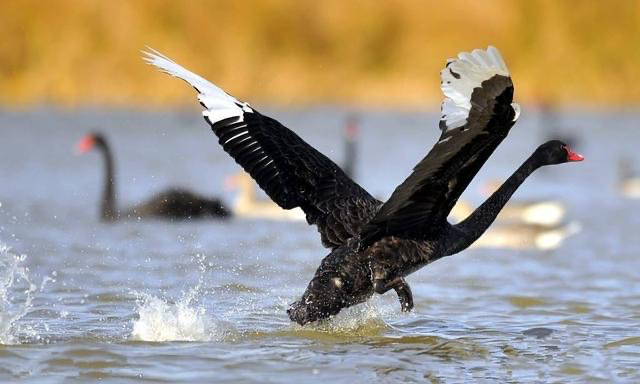Cygnus atratus
IUCN
LCBasic Information
Scientific classification
- name:Cygnus atratus
- Scientific Name:Black Swan
- Outline:Waterfowl
- Family:Anseriformes Anatidae Cygnus
Vital signs
- length:Body length 110-140 cm; wingspan 160-200 cm
- Weight:3.7-8.75kg
- lifetime:40 years in the wild
Feature
It is a world-famous ornamental bird.
Distribution and Habitat
Black swans are native to Australia, including Tasmania. They mainly live in southwestern, southern and eastern Australia. They were later introduced to Spain, the United Kingdom and some Western European countries. A few wandering black swans live in Indonesia and New Guinea. They are farmed in China and Japan.
During the breeding season, they like to live in open, food-rich shallow waters, such as lakes, ponds and slow-flowing rivers rich in aquatic plants, especially in coniferous forests, birch forests and forest-free plateau lakes and ponds. In winter, they mainly live in large lakes, reservoirs, ponds, rivers, beaches and open farmland with a lot of grass.
Appearance
Body length 110-140 cm; wingspan 160-200 cm; weight 3.7-8.75 kg. It is a unique family with a typical swan appearance. Compared with the size of the black swan itself, they have the longest neck among swan species. This slender neck is usually arched or upright in an "S" shape. The plumage of the whole body is curly, the body feathers are flashing, mainly black-gray or black-brown, the abdomen is gray-white, and the flight feathers are white. The tail is long and forked, and the outer feathers are blunt and upturned like a harp. There is a bright waxy beak, which is red or orange-red, with a white horizontal stripe near the end. The iris is red or white, and the tarsus and webs are black. There are 2 subspecies, and the nominate subspecies has a thicker beak.
The black swan is more friendly than the mute swan. The young birds are gray-brown, with light feathers and lighter colors. As with many birds, male swans (called "cobs") are slightly larger than female swan
Details
In my country, swans are regarded as a symbol of beauty, auspiciousness, nobility and holiness. The black swan is the most beautiful species in the swan family. Compared with the white swan, the black swan is more elegant, rational and wise.

Observing the black swan up close is like appreciating a work of art. The feathers are as smooth as silk, especially the curled nuptial feathers on the back are charming, and the whole body is dark and shiny. When flapping its wings, white feathers will be revealed. The long neck, which accounts for half of its body length, often curls into difficult geometric shapes. The extremely charming red eyes, the big red mouth, a white bar near the mouth, and the middle of the mouth is inlaid with a ball-shaped pearl-like soft and bright yellow. The beauty is fascinating and makes people excited!
The black swan is native to Australia and is a large waterfowl. It migrates 2000-6000 kilometers and has a lifespan of 20-35 years. The black swan is both beautiful inside and outside, with a beautiful appearance. The courtship behavior is extremely graceful. The male and female will perform the same intimate actions in a charming way, and will also comb each other's feathers gently and considerately. Love is loyal and inseparable. When the spouse dies, they will find a new partner, otherwise they will stay together for life. After losing their spouse, the white swan will grow old alone. In contrast, black swans are more rational and more conducive to the reproduction of the population.
When encountering natural enemies, black swans will flap their wings to create a loud noise, and stand upright with their beaks pointing downward to threaten and drive away predators. Their eggs and chicks are hunted by Australian ravens, marsh harriers, black rats and water rats, bearded vultures, quolls, sea eagles and other eagles, and sometimes by seagulls and terns.
Listed in the 2016 Red List of Endangered Species of the World Conservation Union (IUCN) ver 3.1 - Least Concern (LC).
The global population of the species is estimated to be around 100,000-1,000,000 (2006), while the population in Japan is estimated to be around 100-10,000, including introduced breeding pairs (2009).








